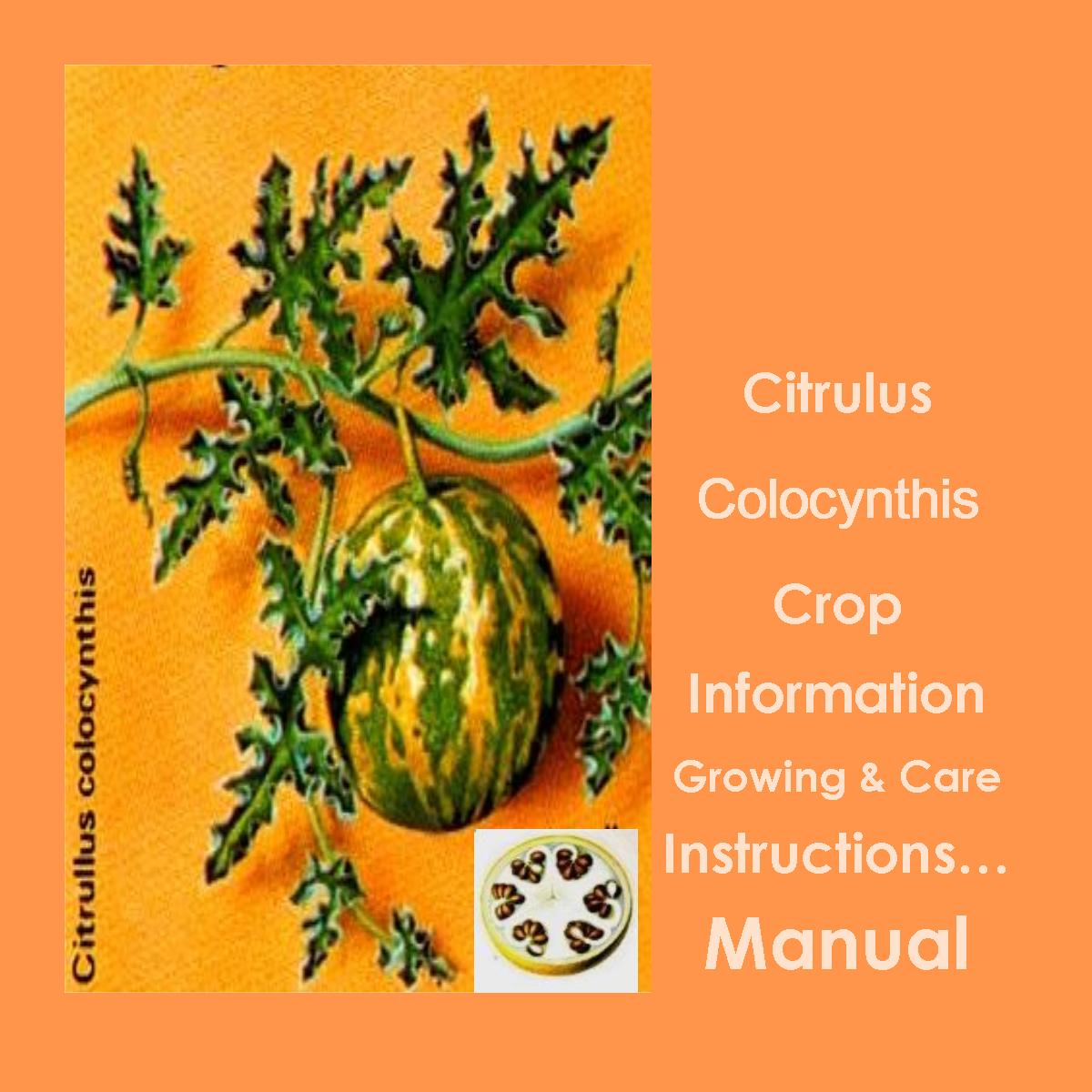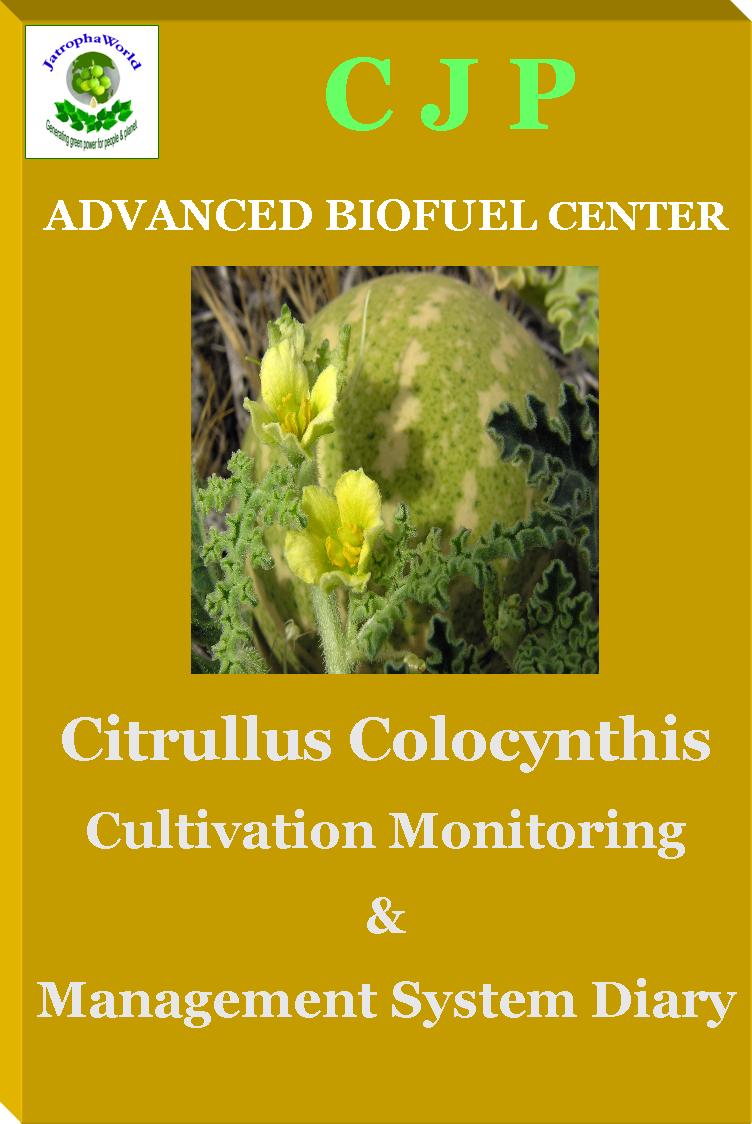 |
|
|||
|
|
| |
 |
|
Citrullus Colocynthis CJP is dedicated to the development of oil seed bearing trees [OSBT] - non-food multiple vegetable oil plantation and technologies in order to reduce Dependence on fossil fuels, bring greater control and security of fuel supply and reduce dangerous climate changing emissions, including CO2. CJP’s Jatropha and other non-food oil crop plantation program. With an effort to ‘grow beyond oil ‘, apart from Jatropha, CJP has identified, developed and cultivated as many as 15 oil seed bearing trees [OSBT] and non-food oil crops. With years of continuing research, experiments and trials has provided an adage to find and develop 2nd generation biodiesel feedstock with low cost input technology. After having a number of successful field trials CJP has honor to establish Citrullus colocynthis - another potential feedstock for Bio- Diesel industry of future because it could serve as fodder and an oil source for biodiesel.
Citrullus colocynthis. a relative of watermelon, egusi is native to tropical Africa and India and highly drought tolerant is a non hardy, herbaceous annual or perennial vine, branched from the base. Originally from Tropical Africa and India, it is now widely distributed in the Saharo-Arabian phytogeographic region in Africa and the Mediteranean region. The stems are angular and rough; the leaves are rough, 5–10 cm in length, deeply 3–7 lobed; solitary pale yellow blooms. Each plant produces 15–30 round fruits, about 7–10 cm in diameter, green with undulate yellow stripes, becoming yellow all over when dry. Seeds are small (~6 mm in length), smooth and brownish when ripe. In recent years there has been much interest in developing new oilseed crops which could be used in food, and for medicinal and industrial purposes. Citrullus colocynthis. Seeds are rich in oil and protein and can be utilized on an industrial scale; such oil composition resembles safflower oil. Considering Citrullus colocynthis.’s potential as an oilseed feedstock for biodiesel CJP has honor to establish this untapped resource as alternative source for Bio- Diesel industry of future. The Citrullus colocynthis. Plant must be regarded as a sure source of 2nd Generation Biodiesel and the foundation around which a profitable Business plan can be built with combination of other nonfood biodiesel crops for its ability to provide large amount of oil and its pure hardiness and stress handling ability. The Citrullus colocynthis. has enough credentials: a higher recovery and quality of oil than other crops, no direct competition with food crops and no direct competition with existing farmland as can be grown for fuel and fodder, both purpose same time CITRULLUS COLOCYNTHIS: BOTANICAL DESCRIPTION Annual or perennial (in wild) herbaceous vine; stems angular and rough; leaves rough, are angular 3- to 7-lobed, 5-10 cm long, middle lobe sometimes ovate, sinuses open; The flowers are yellow, long-peduncled, and solitary in the axils of the leaves. They are monecious, the stamens and pistils being borne in different flowers on the same plant. Each has a yellow campanulate, five-lobed corolla and a five-parted calyx. The female flowers are readily distinguished by a globose, hairy, inferior ovary; fruit a pepo, nearly globular, 4-10 cm in diameter with somewhat elliptical fissures, about size of small orange, green and yellow variegated becoming yellow when ripe, with hard rind, pulp light in weight, spongy, easily broken, light yellowish-orange to pale yellow; intensely bitter; seeds numerous, ovoid, compressed, smooth, dark brown to light yellowish-orange, borne on parietal placenta.. It is filled with a soft, white pulp, in which are imbedded numerous seed .This pulp is the article used in medicine,
The colocynth plant is a native of arid soils. It has a large, fleshy perennial root, which sends out slender, tough, angular, scabrid vine-like stems. These usually lie on the ground for want of something to climb over, but which, if opportunity present, climb over shrubs and herbs by means of axiliary branching tendrils. Cultivated and naturalized in North Africa and India. The colocynth plant occupies the vast area extending from the west coast of northern Africa (Senegambia, Morocco and the Cape Verde islands), eastward through the Sahara, Egypt, Arabia, Persia, Beluchistan and through India, as far as the Coromandel coast and Ceylon, touching northward the Mediterranean and Caspian seas. At the Red sea, near Kosseir, it occurs in immense quantities. It is also found here and there in southern European countries, e. g., Spain and the islands of the Grecian archipelago. Cultivation on a small scale in the island of Cyprus the raising of colocynth has been a source of revenue since the fourteenth century, and still forms an article of export at the present time.
Climate Ranging from Cool Temperate Moist through Tropical Desert to Wet Forest Life Zones, colocynth is reported to tolerate annual precipitation of 250mm to 1500 mm, annual temperature of 14.8 to 27.8°C, and pH of 5.0 to 7.8. A highly xerophytic plant, it thrives where mean annual temperature is from 23-27°C and annual rainfall ranges from 25-37 cm. it is relatively tolerant of drought and poor soils, and responds well to irrigation and fertilization. Soils It is found wild in the warm, arid and sandy parts throughout India, up to 1,500 m. It is most abundant in north- western plains of India, especially in the Barmer, Bikaner, Jaisalmer and Jodhpur districts of Rajasthan, and in Gujarat. Thrives on sandy loam, sub desert soils, and along sandy sea coasts . BIOPHYSICAL LIMITS
AGROTECHNIQUES CULTIVATION TECHNOLOGY The Colocynth is native to India but has naturalized across tropical and subtropical regions. The Colocynth has incredible nutritional value, low demand for water and prolific growth and biomass production. As the seeds do not form a staple food source, the food for the people or food for fuel issue is argued to be not relevant. Also, the Colocynth is able to grow in marginal lands and has the potential to improve the quality of the soil and is documented as having improved the size and quality of vegetable crops that have been intercropped with Colocynth. The productive plantation of Colocynth needs to be scientifically managed for better growth and production. The growth and yield of the plant could be improved through effective management practices. The enhanced cultivation technology and improved inputs developed by CJP may provide about 3 K liters of biodiesel without displacing food crop and without utilizing prime food land in terms of sustainable farming techniques CJP is happy to announce the market release of New Oil Crop technology “Citrullus colocynthis Cultivation Technology” at an affordable Price Citrullus Colocynthis Crop Information Growing & Care Instruction Manual and Monitoring & management system
As all biological organisms require care and attention, the need to draw Growing Instructions was being felt by all concerned Therefore keeping in view Various concerns and problems of a new Grower; CJP being “The Centre of Excellence” has designed Citrullus Colocynthis Growing & Care Instructions Manual with Monitoring & Management System Diary on the basis of our own tried, tested, developed and experienced Plant Propagation and Cultivation Technologies and Practices to help you grow a Failsafe Citrullus Colocynthis Fuel Farm The Citrullus Colocynthis Growing & Care Instructions manual provides basic guidance for the project developers to help ensure successful Citrullus Colocynthis cultivation projects. Proper planning, cultivation and maintenance are the key for growing flourishing plants. Simply putting a plant in the ground is not enough. Careful thought must be given to the purpose of the cultivation, location of the cultivation and how the Citrullus Colocynthis will be cared for once they are in the ground. A properly planted and maintained plant will grow faster and live longer than one that is incorrectly planted. This booklet is organized as a step-by-step checklist of fundamentals to help you with your Citrullus Colocynthis cultivation project We have sincerely tried to put all steps in nutshell and hope it will be a useful tool in growing your Biodiesel Plantation Both the Citrullus Colocynthis publications are available Order Just Know Agricultural Extension Kit CJP has specifically developed and designed a unique kit for Citrullus ColocynthisL plantation and crop care for 1 hectare called: “Agricultural Extension Kit” – a key to your fuel farm “just enables & encourages the farmers/ new growers to start the Biodiesel crop cultivation in a right and prefect manner by adopting the concept of “sustainable agriculture”. Citrullus Colocynthis Starter Kit: Citrullus Colocynthis Agri- Extension Kit contains 1. SRIPHL CC03 Elite cultivation stock for cultivation in 1 ha 2. an easy- to- follow growing and crop care instructions manual 3. a very typical monitoring and management diary Order Just Know Citrullus colocynthis HYV Elite Seeds 
Order Just Know Economics & BUSINESS PLAN Citrullus Colocynthis: A Viable Biodiesel Feedstock? As the biodiesel industry grows, honing a cost-effective and diverse feedstock supply stands out as a top challenge. There is a need to diversify the sources and methods used to generate biofuel products to achieve food security, energy security and sustainable development and carbon savings. Biodiesel producers are looking for alternative feedstocks which are non- agricultural and non-food crops. And Citrullus colocynthis has the ability to substitute the requirement of low cost feedstock with the potential for high oil seed production and the added benefit of an ability to grow on marginal land. These properties support the suitability of this plant for large scale vegetable oil production needed for a sustainable biodiesel industry. The seeds from the Colocynthis contain in up to 47% oil. The main use of the oil will be as bio fuel and for the production of biodiesel. This oil can also be used for medicinal and soap production. Once the oil has been extracted, the byproducts can be used for many purposes. The plant thrives without any attention whatever on the part of the husbandman, since the climate and soil are all-sufficient for its perfect growth-the natural requirements being merely a sandy soil, warm climate and little moisture. Productivity is enhanced during dry, sunny periods and reduced during periods of excessive rainfall and high humidity. . Fruits gathered when still unripe but fully developed. Fruit is hand-picked, the thin, hard, gourd-like outer ring (pericarp) removed by peeling, and inner white spongy pulp filled with seeds, is dried in the sun or in ovens. Seeds constitute about 75% the weight of the dried product Yields of 6,700-10,000 kg/ha are attainable with low energy inputs, and if oil yields are 31-47%, oil yields might exceed 3,000 kg/ha, placing this among the serious oilseed energy candidates, with medicinal byproducts. BUSINESS PLAN CITRULLUS COLOCYNTHIS BUSINESS PLAN
Sample/ready built Biodiesel business plans are drawn in universal scenario based on optimum conditions for growing the biodiesel crop worldwide and on crop specific science, agronomy and economy in wider context Sample/readymade business plan are available for 20 hectare, 100 hectare and 500 hectare as per details on page http://www.jatrophaworld.org/biodiesel_business_plan_95.html Feasibility Study Report We recommend carrying out Feasibility Study Report for project size of 5000 hectares or more to determine the land identification and suitability of growing the Citrullus colocynthis Customized, Complete & Comprehensive Business Plan With its extensive experiences in the field, enhanced technology, plant science & professional knowledge, effective consulting service and business intelligence CJP can clearly understand the business model, products and services, production, marketing and provides all aspects of feasibility analysis and business development including assessments of the following: crop production, crushing, co-product markets, feedstock acquisition and contracting, technology analysis, risk analysis specific to biodiesel technology, feedstock, markets, and general project risks, market and financial analysis. We make the integration of our experience and professional knowledge with your information. We provide in Depth analysis of crop cultivation and crop care part of plan for which we have team of agronomist and plant scientists, and then we have engineers and experts in biodiesel industries to finish the technology and production part of business plan. We have professionals in accounting to complete financial and economics part. CJP can offer the type of consulting that only numerous years of leadership in the biodiesel market can provide at an affordable price. CJP can help clients identify the needs, opportunities and solutions of their local, regional and national markets. By identifying these needs and providing management direction, CJP can help in creating a perfect business plan in order to develop and manage an effective and successful biodiesel facility. The most critical component of any business plan is the pro forma, an educated view or projection of what the performance of a company is capable of, given a specific set of assumptions and conditions. CJP has been involved in identifying these needs for specific projects for a number of years and can help develop a realistic and obtainable: Income Statement Balance Sheet Capital Budget Cash Flow Break-even Analysis Sensitivity Analysis Assumptions Governing the Pro-jections For detailed Cost-Benefit Analysis of Citrullus colocynthis Growing and For a detailed quote for a complete and comprehensive Citrullus colocynthis Farming Business Plan from Farming to fuel, kindly mail to jatrophaplan@gmail.com Folk Medicine In recent years there has been much interest in developing new oilseed crops which could be used in food, and for medicinal and industrial purposes (Yaniv et al. 1994). Many melon seeds (Cucurbita spp., Citrullus spp.) are rich in oil and protein (Al-Khalifa 1996) and although none of these oils has been utilized on an industrial scale, can be used for biodiesel production Considered cathartic, ecbolic, emmenagogue, febrifuge, hydragogue, purgative, and vermifugal, the colocynth is used for amenorrhea, ascites, bilious disorders, cancer, fever, jaundice, leukemia, rheumatism, snakebite, tumors (especially of the abdomen), and urogenital disorders. According to Hartwell the plant figures into remedies for cancer, carcinoma, endothelioma, leukemia, corns, tumors of the liver and spleen, even the eye. It is interesting to note that this folk cancer "remedy" contains three antitumor ingredients: cucurbitacin B (active against PS-134 and KB tumor systems), cucurbitacin E (active against LL and KB systems) and the D-glucoside of beta-sitosterol (active against CA, LL and WA tumor systems). The pulp or leaves is a folk remedy for cancerous tumors. A decoction of the whole plant, made in juice of fennel, is said to help indurations of the liver. Roots may also be used as purgative against ascites, for jaundice, urinary diseases, rheumatism, and for snake-poison. Active drug contains an ether-chloroform soluble resin, a phytosterol glycoside (citrullol), other glucosides (elaterin, elatericin B and dihydro-elatericin B), pectins and albuminoids. Bitter substance is colocynthin and colocynthetin. Roots contain a-elaterin, hentriacontane, and saponins. Per 100 g, the seed is reported to contain 556 calories, 6.7 g H2O, 23.6 g protein, 47.2 g fat, 19.5 g total carbohydrates, 1.5 g fiber, 3.0 g ash, 46 mg Ca, and 580 mg P. The oil contains oleic, linoleic, myristic, palmitic, and stearic acids. Seeds contain the phyto sterolin (ipurand), 2 phytosterols, 2 hydrocarbons, a saponin, an alkaloid, a polysaccharide or glycoside, and tannin. The root is used for arthritic pain, breast inflammation, ophthalmia and uterine pain. The fruit is used for adenopathy, anaemia, ascites, asthma, bronchitis, constipation, dyspepsia, elephantiasis, foetal atrophy, jaundice, leucoderma, spleeno-megaly, throat diseases, tubercular glands, tumors, ulcers, and urinary discharges. Indravaruni, an Ayurvedic preparation from leaves is used for treatment of cough and as a cholagogue. Oil from the seeds is useful in hair growth and sterility The mesocarp contains glucose (1.3% on fresh basis) and traces of a-spinasterol. The juice of the fruit contains a-elaterin, citrulluin, citrulluene, and citrulluic acid. A dihydric alcohol, citrullol and p-hydrooxy-benzyl-methylether have been isolated from the dried pulp and the unripe fruits respectively. The peel-free flesh of ripe fruit contains a yellow, bitter oil, citbittol. The petroleum ether extract of peels of the fruit contains a mixture of 22 hydrocarbons of which the major was hentriacontane (48.2%), fatty acids (lauric, myristic, palmitic, hexadecenoic, stearic, arachidic, oleic and linoleic), primary alcohols (hexadecan-1-ol,octadecan-1-ol, eicosan-1-ol, docosan –1-ol, tetracosan-1-ol and hexacosan-1-ol), odouriferous compounds (citronellal, methylheptenone, methyl eugenol, phenylethylalcohol and 3 unidentified compounds) and a long chain unsaturated ketone. Other compounds present in the peels are: docosan-1-ol acetate, 10,13-dimethylpentadec-13-en-1-al, 11,14- dimethylhexadecan-14-ol-2-one and 10,14-dimethyl-hexadecan-14-ol-2-one. Presence of citrullol and heptacosan-1-ol is also reported. Seeds contain phytosteroline, 2 phytosterols, 2 hydrocarbons, a saponin , an alkaloid, a polysaccharide or glycoside, and tannin. The two phytosterols may be b- sitosterol and lanosterol detected in all parts of the plant. Quercetin, and salts of acetic -, malic-, citronic-, and tartaric - acids as well as caffeic-, chlorogenic-, ferulic-and m - coumaric acids and a - spinasterol have also been reported. Seeds contain a pale brownish yellow fixed oil with a characteristic flavour and taste. Roots contain a-elaterin, hentriacontane and saponin. Trade and commerce
For further details kindly mail to moringabiodiesel@gmail.com or contact Assistant Director , CJP |
© 2004- 2025 ABC-Advanced Biofuel center ,, All Rights Reserved |


 The cultivation,
looking after and harvesting plants is an important factor and it requires a
lot of knowledge, skill and techniques viz: the best cultivation season to make
the plant early matured, then an amount of seeds to be planted, an irrigation
& fertilization method, a control method of weeds , investigate
quality, yield, and degree of occurrence of several troubles .
The cultivation,
looking after and harvesting plants is an important factor and it requires a
lot of knowledge, skill and techniques viz: the best cultivation season to make
the plant early matured, then an amount of seeds to be planted, an irrigation
& fertilization method, a control method of weeds , investigate
quality, yield, and degree of occurrence of several troubles . Sample/
Ready Built Business Plans
Sample/
Ready Built Business Plans